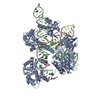+Search query
-Structure paper
| Title | Structure-Guided Engineering of Thermodynamically Enhanced SaCas9 for Improved Gene Suppression. |
|---|---|
| Journal, issue, pages | Adv Mater, Vol. 37, Issue 26, Page e2404680, Year 2025 |
| Publish date | Jun 30, 2024 |
 Authors Authors | Eun Sung Kang / Nam Hyeong Kim / Hyun-Kyoung Lim / Hyeyeon Jeon / Kayoung Han / Young Hyun No / Kyungtae Kim / Zinah Hilal Khaleel / Dongsun Shin / Kilho Eom / Jiyoung Nam / Bok-Soo Lee / Han-Joo Kim / Minah Suh / Jaecheol Lee / Trung Thanh Thach / Jaekyung Hyun / Yong Ho Kim /  |
| PubMed Abstract | Proteins with multiple domains play pivotal roles in various biological processes, necessitating a thorough understanding of their structural stability and functional interplay. Here, a structure- ...Proteins with multiple domains play pivotal roles in various biological processes, necessitating a thorough understanding of their structural stability and functional interplay. Here, a structure-guided protein engineering approach is proposed to develop thermostable Cas9 (CRISPR-associated protein 9) variant for CRISPR (Clustered Regularly Interspaced Short Palindromic Repeats) interference applications. By employing thermodynamic analysis, combining distance mapping and molecular dynamics simulations, deletable domains are identified to enhance stability while preserving the DNA recognition function of Cas9. The resulting engineered Cas9, termed small and dead form Cas9, exhibits improved thermostability and maintains target DNA recognition function. Cryo-electron microscopy analysis reveals structural integrity with reduced atomic density in the deleted domain. Fusion with functional elements enables intracellular delivery and nuclear localization, demonstrating efficient gene suppression in diverse cell types. Direct delivery in the mouse brain shows enhanced knockdown efficiency, highlighting the potential of structure-guided engineering to develop functional CRISPR systems tailored for specific applications. This study underscores the significance of integrating computational and experimental approaches for protein engineering, offering insights into designing tailored molecular tools for precise biological interventions. |
 External links External links |  Adv Mater / Adv Mater /  PubMed:38944889 PubMed:38944889 |
| Methods | EM (single particle) |
| Resolution | 2.97 Å |
| Structure data | EMDB-39633, PDB-8ywh: |
| Source |
|
 Keywords Keywords | DNA BINDING PROTEIN / CRISPR/Cas9 / Thermostable protein engineering / Domain minimized Cas / engineered SaCas9 |
 Movie
Movie Controller
Controller Structure viewers
Structure viewers About Yorodumi Papers
About Yorodumi Papers






